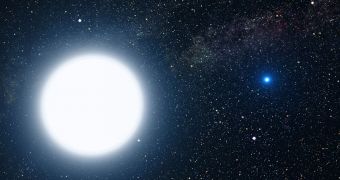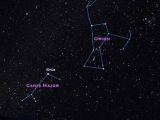It is the brightest star on the night sky, however if one is to go outside on a clear night it wouldn't appear very different from the other bright stars located in the vicinity of our solar system, thus people often have difficulties locating it. This week you once again have the opportunity to go outside and become amateur astronomer, even if for only a couple of minutes. The Moon's increased brightness will increase the contrast, giving you a bit of help by leaving visible only the most luminous stars on the night sky.
Located in the Canis Major constellation, about 8.7 light years away from Earth, Sirius, or 'The Star in the East' as ancients named it, is the fifth closest star to us. You can easily find it by locating the Orion's belt, which is pointing towards Sirius in a southeast direction or by simply observing the south regions of the sky during the winter season, just after sunset. Sirius is the first star to become visible in the southern regions of the sky.
On a clear sky, it will appear as a bright white spot of light with a tinge of blue, albeit air turbulence may sometimes make it flicker and appear in all of the colors of the visible spectrum. Being so closely located to us, Sirius is probably one of the first stars to be observed while moving in relation to the stars in the vicinity of the solar system. Astronomical observations, since ancient times, reveal that Sirius may move as much as the apparent width of the moon in 1,500 years.
One of the first astronomers to precisely measure Sirius was German scientist Friedrich Wilhelm Bessel, who revealed that, in fact, Sirius followed a wobbling trajectory through space, meaning that it must have an invisible companion orbiting around it and calculated that the time required for a complete orbit would be about 50 years. Continuing Bessel's work, Alvan G. Clark showed that the companion Sirius B would have a brightness of only one ten-thousandth that of Sirius A. Nonetheless, a later study using spectroscopic observations finally revealed that Sirius B is in fact as bright as Sirius A.
This would only mean that, to be invisible from Earth, Sirius B would have to be extremely small. Sirius A is almost two times heavier than the Sun, while its companion has a mass about 98 percent that of the Sun and a diameter of 2 percent of the solar diameter, meaning that it is 90,000 times denser than the Sun.
The ancient civilizations had special days in the calendar associated with Sirius, or the Dog Star - as it is commonly known, between July 3 and August 11. Some even though that the simultaneous arise of longer day and the brightest star in the sky were directly connected to the intense heat during summer days, or other disastrous events such as droughts or appearance of plagues.
In the Egyptian civilization for example, Sirius was known as the 'Nile Star' as its rising about 5,000 years ago took place on 25th of June, simultaneous with the Sun, thus announcing the 'Nile Days' warning people about floods along the river Nile.

 14 DAY TRIAL //
14 DAY TRIAL // 
